
About UsThe Numismatic Bibliomania Society is a non-profit organization devoted to the study and enjoyment of numismatic literature. For more information please see our web site at coinbooks.org SubscriptionsThose wishing to become new E-Sylum subscribers (or wishing to Unsubscribe) can go to the following web page link MembershipThere is a membership application available on the web site Membership Application To join, print the application and return it with your check to the address printed on the application. Membership is only $20 to addresses in the U.S., $25 for First Class mail, and $30 elsewhere. For those without web access, write to: David M. Sundman, Treasurer AsylumFor Asylum mailing address changes and other membership questions, contact David at this email address: dsundman@LittletonCoin.com SubmissionsTo submit items for publication in The E-Sylum, just Reply to this message, or write to the Editor at this address: whomren@gmail.com
BUY THE BOOK BEFORE THE COIN |
- WAYNE'S WORDS: THE E-SYLUM APRIL 5, 2015
- NEW BOOKS IN THE MONETA SERIES: #183-184
- EL SITIO NO. 14 PUBLISHED
- NEWMAN NUMISMATIC PORTAL INTERVIEW MARCH 2015
- APRIL FOOL: PIERCED COINS
- DAVID GANZ ON FRANKLIN MINT FOUNDER JOSEPH SEGEL
- THE FRANKLIN MINT AFTERMARKET
- NOTES FROM E-SYLUM READERS: APRIL 5, 2015
- MANKATO DAKOTA INDIANS HANGING ITEMS
- MORE ON COIN DEALER CHARLES L. STAKE
- MORE ON THE MONTROVILLE DICKESON PHOTO
- SELECTIONS FROM THE POGUE COLLECTION, PART I
- COMPARISON BETWEEN COIN AND BOOK COLLECTING
- RAY WILLIAMS FEATURED IN APRIL 2015 NUMISMATIST ARTICLE
- HAND-ENGRAVED 1849 PATTERN GOLD DOLLAR
- FREEDOM’S FIRST CON
- DIX NOONAN WEBB OFFERS AUSTRALIAN CONVICT TOKENS
- STANLEY GIBBONS FAILS TO COLLECT FOR £1M COIN SALE
- QUEEN HOSTS 2015 MAUNDY SERVICE
- PERSHING AND MARSHALL CONGRESSIONAL GOLD MEDALS
- CHARLES RILEY NUMISMATIST MEDAL 2015
- MEDALLIST JOSEPH MOORE
- MALAYSIA BANK AUCTIONS SPECIAL SERIAL NUMBERS
- DEFIANCE BANK BUILDING HOUSES TUTTLE MUSEUM
- HARLAN J. BERK 193RD BUY OR BID SALE
- BANKNOTE ORIGAMI ANIMALS DISPLAYED IN RUSSIA
- FEATURED WEB PAGE: EXONUMIST.COM
Click here to access the complete archive
To comment or submit articles, reply to whomren@gmail.com
WAYNE'S WORDS: THE E-SYLUM APRIL 5, 2015

New subscribers this week include: Gary Smith, Jeffrey Gresser, Gail Rollins and Robin Hill. Welcome aboard! We now have 1,844 subscribers.
This week we open with two new books, one new periodical, and a video interview about the Newman Numismatic Portal project. Other topics include April Fool articles, early coin dealer Charles Stake, the Pogue Collection, coin and book collecting, and the 2015 Royal Maundy service.
To learn more about Royal Proclamation medals of Fernando VII, Joe Segal, Charles Riley, Ray Williams, the Tuttle Museum, Ed Moy's phone number, the Mankato Indian uprising, John Dannreuther's broken arm, and a hand-engraved U.S. pattern coin, read on. Have a great week, everyone!
Wayne Homren
Editor, The E-Sylum
NEW BOOKS IN THE MONETA SERIES: #183-184

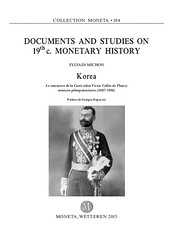
Latest MONETA publications (March 2015)
M 183, J. Ch. Moesgaard, Les trésors monétaires médiévaux découverts en Haute-Normandie (754-1514), Collection Moneta, 183, Wetteren, 2015, 308 p. ISBN 978-94-91384-51-6
For more information, or to order, see: www.moneta.be/volumes/moneta_183.htm
M 184, Documents and Studies on 19th c. Monetary History, Korea, Le commerce de la Corée selon Victor Collin de Plancy ministre plénipotentiaire (1887-1906), S. Michon, préf. de G. Depeyrot, Collection Moneta, 184, Wetteren, 2015, 152 p. ISBN 978-94-91384-52-3
For more information, or to order, see: www.moneta.be/volumes/moneta_184.htm
Order on Moneta www.moneta.be with Paypal Order on disdocs http://disdocs.com/index.php?manufacturers_id=11 with Visa and MasterCard Follow Moneta on Facebook https://www.facebook.com/collection.moneta
MONETA publishes books on numismatics, monetary history, economy, from antiquity to present, all continents, all languages, see www.moneta.be.
EL SITIO NO. 14 PUBLISHED
 “El Sitio” N° 14 contains, in its 34 pages, three numismatic articles and the chronicle of the New Year celebrations.
“El Sitio” N° 14 contains, in its 34 pages, three numismatic articles and the chronicle of the New Year celebrations.
The cover of “El Sitio” N° 14 shows the pictures of the 4 centesimos gold pattern minted in Paris in 1869. The set of three gold patterns (4, 2 and 1 centesimos) was auctioned by Heritage Auctions for $ 49,350 in January 5th, 2015.
The three published articles are the following:
1) Conchillas and its tokens: the Walker ranch and the Evans grocery, by Miguel Garepe Sallé. This is a nice story of these two issuers of tokens in the Conchillas city, in the Colonia Department.
2) Royal Proclamation medals of Fernando VII: initial fidelity to the Spanish monarch in the Virreinato del Río de la Plata, by Santiago Blanco.
3) Identifying shearing tokens (fourth part), by Horacio Morero. This article refers to five Ranchs: “Santa María” and “La Esperanza” in Durazno Department; “La Pradera” and “San Juan” in the Cerro Largo Department and “El Coronilla” in the Flores Department.
To read the complete issue, see:
www.iunuy.org/designroom00/wp-content/uploads/2014/03/ElSitioN%C2%BA14.pdf

NEWMAN NUMISMATIC PORTAL INTERVIEW MARCH 2015

At the Whitman Baltimore show last Friday I stopped by the CoinWeek table and was interviewed on video by Charles Morgan about the Newman Numismatic Portal project. David Lisot ran the camera, and he deftly fitted me up with a microphone, like an experienced tailor measuring for a bespoke suit. Charles took two pens from my shirt pocket, noting "...or else you'll look like Poindexter." These guys are clearly pros who have done this before. We did it all in one take, and I think it came out pretty well. Check it out. There will be something in the portal for every numismatist.
Chris Fuccione was the first E-Sylum reader to notice this was published. Thanks!
To view the complete video, see:
CoinWeek: Coin Info to Be Online with Newman Numismatic Portal Project. VIDEO: 4:27.
(www.youtube.com/watch?v=FuLBxnlThHM)
APRIL FOOL: PIERCED COINS
Ralf Böpple of Stuttgart, Germany writes:
I got very excited by the headlines, reading that there would be a study on holed coins (one of the greatest mysteries for anybody collecting Mexican coins, like me). However, the article itself quickly left a hole in my heart...
By the way, the German word for hole is "Loch", just like the Scottish lakes (but from a different etymological background). It thus comes complete with the famous guttural sound that apparently German is famous for...
Bob Van Arsdell writes:
No mention of bitcoin files with holes in them?
Anne Bentley writes:
Great April Fool's article, Wayne. Kind of makes me wish the hole book was real ;-)
On a related topic, Ken Barr writes:
I posted my annual April Fool's Day article in the Usenet rec.collecting.coins newsgroup on 4/1. "New 'First Slabbed' Procedure Announced by American Numismatic Association"..
To read the complete article, see:
APRIL FOOLS!!!!
(www.kenbarr.com/aprilfools.html)
Scott Barman got in on the act in his Coin Collectors Blog:
Congress Reauthorized Old Denominations
(http://coinsblog.ws/2015/04/congress-reauthorized-old-denominations.html#sthash.RTpCVRUj.dpbs)
And don't forget the American Numismatic Society's April 1, 2015 post:
BUDDING BILLS PERPLEX NUMISMATISTS
(www.anspocketchange.org/money-harvest/)

To read the earlier E-Sylum article, see:
NEW BOOK: PIERCED COINS
(www.coinbooks.org/esylum_v18n13a03.html)
DAVID GANZ ON FRANKLIN MINT FOUNDER JOSEPH SEGEL
The item about Joe Segel is the cause of my writing this email late on Sunday night. To say that his actions with Franklin Mint ignore serious numismatics (relegating him to the medal man) just doesn’t begin to reflect how intense a person he was and how he influences modern numismatics even today.
Joe was born in 1931 and by a remarkable coincidence, went to high school in suburban Philadelphia with my ex-wife’s mother, Irene Lamnin. I was looking one day (casually) at her year book and found Joe’s picture labelled “Most Like to Succeed”. Wow, did he.
Joe figured out that you could take a lump of precious metal (first silver, later gold) invest in die charges and striking (minting) charges, and then triple his money after expenses.
Joe was a marketing genius (he also founded QVC) and hired top talent like GIlroy Roberts, then Chief Engraver of the US Mint (Joe hired him away), and strongly promoted the Token & Medal Society and the American Numismatic Association.
Segel opposed bicentennial medals, not coins but ultimately accepted the Bicentennial Commission's recommendation to do both.
My untold story about Joe Segal is that in 1969, just after I started college at Georgetown University, I was already well-known in the hobby as a writer. (My column “Under the Glass” was running in Numismatic News Weekly in addition to spot news items). So imagine my surprise when a letter from Franklin Mint arrived offering me a job with all of three weeks of college under my belt. (The salary was around $19,000 as I remember, stock options, and a whole lot more.)
I never calculated what that would have been worth (and didn't become a Franklin Mint stockholder until the following year), but the stock went from $1.42 (in 1967) to over $42 a share by 1969 and then kept splitting. Eventually it became part of Time Warner and America on Line (AOL). But I am getting ahead of myself.
All I ever wanted to be was a lawyer, so I said no., stayed the course, and as you know from my comment a couple of weeks ago, almost went to work for FAO (the oldest independent UN agency) after graduating Georgetown and going to work at Krause in Iola.
Anyway Joe Segel not only made medals but Franklin pioneered private mints striking foreign coinage - not only circulation strikes but proof versions for collectors.
Joe Segel is 84 or so now and I haven’t seen or heard from him in years, but, wow, did his action have an impact on my life!
To read the earlier E-Sylum article, see:
A SHORT HISTORY OF THE FRANKLIN MINT
(www.coinbooks.org/esylum_v18n13a14.html)

THE FRANKLIN MINT AFTERMARKET
Ken Potter writes:
Yes, the Pharmacy Set, the Freemasonry set, and some other very limited editions have always done well for me. I've been looking for over 20 years for a Franklin Mint Collectors Society Cruise medal to Mexico. I'd pay quadruped spot or more to get one. I have all the others. Additionally, many pieces taken from sets have topical interest and sell well -- Babe Ruth, bla bla bla. Corvette ingots also do well.
To read the earlier E-Sylum article, see:
A SHORT HISTORY OF THE FRANKLIN MINT
(www.coinbooks.org/esylum_v18n13a14.html)
NOTES FROM E-SYLUM READERS: APRIL 5, 2015
Queries: Judd, Lohr Birch Cents Sought Saul Teichman writes:
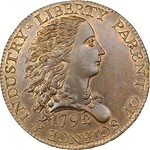 Does anyone know who owns Dr. Judd’s plain edge Birch Cent which is the only other believed to grade Uncirculated besides the recently sold Garrett-Patrick coin ?
To my knowledge, it has not appeared since its offering in the Kosoff’s Illustrated History of US Coins which was a fixed price list of Dr. Judd’s coins.
Does anyone know who owns Dr. Judd’s plain edge Birch Cent which is the only other believed to grade Uncirculated besides the recently sold Garrett-Patrick coin ?
To my knowledge, it has not appeared since its offering in the Kosoff’s Illustrated History of US Coins which was a fixed price list of Dr. Judd’s coins.
Also, the fixed price list of the Lexox Lohr patterns had a lettered edge example graded XF which is also unidentified.
Any help the E-sylumites can supply would be greatly appreciated.
To read the earlier E-Sylum article, see:
THE BUSHNELL-PARMELEE BIRCH CENT BRINGS $1.2M
(www.coinbooks.org/esylum_v18n13a16.html)
The Birth Cent Sold by Stack's-Bowsers Galleries Tom DeLorey writes:
As to the $1.2 million "penny," here is a news blurb that called it a "Birth Cent." If you watch the attached video, you will see that it was sold by "Stack's-Bowsers Galleries!"
To read the complete article, see:
America’s first penny sold at auction, worth way more than 1 cent
(http://fox2now.com/2015/03/28/americas-first-penny-sold-at-auction-worth-way-more-than-1-cent/)
To read the earlier E-Sylum article, see:
THE BUSHNELL-PARMELEE BIRCH CENT BRINGS $1.2M
(www.coinbooks.org/esylum_v18n13a16.html)
Another Reason to Like Ed Moy 1792 was a hugely important year for American coinage. When a 1792 Birch cent sold recently, former U.S. Mint director Ed Moy tweeted
Prototype US penny sold for 117.5 million pennies. There's a reason why my cell # ends in 1792!
To read the complete tweet, see:
Prototype US penny sold for 117.5 million pennies. There's a reason why my cell # ends in 1792!
(https://twitter.com/EdmundCMoy/status/581673823575121921)
Where is Victor, Colorado?
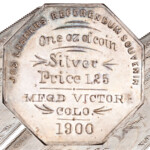 On a different topic, Tom DeLorey writes:
On a different topic, Tom DeLorey writes:
A minor quibble...Victor, Colorado is Southeast of Cripple Creek, not Southwest. We drove through there last Summer after visiting Cripple Creek.
Dave Hirt adds:
On the Lesher Dollars, there was a detailed account written by Dr. Philip W.Whiteley, serialized in the Numismatic Scrapbook Magazine in the 1958 Oct.-Dec. issues. It gave history, photos of the coins, pedigree information, and rarity. If any of our readers have these issues, I believe they will find them interesting.
To read the earlier E-Sylum articles, see:
LESHER REFERENDUM DOLLARS
(www.coinbooks.org/esylum_v18n13a12.html)
Red Book Frosted Flakes
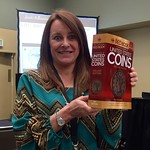 Dave Lange writes:
Dave Lange writes:
When I saw Mary Burleson holding the deluxe Red Book it took me a second or two to realize that it was not a box of cereal. That's exactly what it looks like in the photo, and I thought, Wow! That's cross-marketing in the extreme---Red Book Frosted Flakes.
To read the earlier E-Sylum article, see:
NOTES FROM E-SYLUM READERS: MARCH 29, 2015 : The New Deluxe Redbook
(www.coinbooks.org/esylum_v18n13a08.html)
Coins of the British World
 Ed Hohertz came through with a nice image of the dust jacket from Robert Friedberg's book Coins of the British World (1962). Thanks! E-Sylum readers are the best.
Ed Hohertz came through with a nice image of the dust jacket from Robert Friedberg's book Coins of the British World (1962). Thanks! E-Sylum readers are the best.
To read the earlier E-Sylum article, see:
NOTES FROM E-SYLUM READERS: MARCH 29, 2015 : 'Coins of the British World' Cover Image Sought
(www.coinbooks.org/esylum_v18n13a08.html)
Numismatic Library Photos
 Dave Hirt writes:
Dave Hirt writes:
I really enjoyed the photos of the west coast library. I remember when I suggested readers do that, and sent photos of my library. Several people told that they liked them.
To read the earlier E-Sylum articles, see:
THE DAVID HIRT NUMISMATIC LIBRARY
(www.coinbooks.org/esylum_v15n31a18.html)
A WEST COAST NUMISMATIC LIBRARY
(www.coinbooks.org/esylum_v18n13a35.html)
MANKATO DAKOTA INDIANS HANGING ITEMS
Pete Smith writes:
I grew up in New Ulm, Minnesota, about thirty miles upriver from Mankato. In August of 1862 the town was attacked twice by Indians. In early years this was called the Indian Massacre of 1862. Local militias repelled both attacks but the town was later evacuated to Mankato.
I graduated from high school in 1962, the year of the centennial commemoration of the event, then known as the Sioux Uprising of 1862. I participated in various events related to the centennial.
I then went to college in Mankato. I was very familiar with the site of the hanging. At one time a local museum had one of the timbers from the scaffolding used to hang the 38 Indians. I heard later that the timber had gone missing..
Another fifty years have passed and the event is now known as the Dakota Conflict of 1862, unless I have missed another politically correct change of name. I certainly would have paid attention to a medal depicting the hanging, but I can't recall seeing one.
There are a number of badges and medals related to the events in New Ulm. I have looked through the collection of such medals at the Brown County Historical Society. They do not appear on the market frequently and are expensive when offered.
There is a beer tray depicting the hanging in 1862 and some print items. Again they are actively collected.
I haven't visited the Blue Earth County Museum since I graduated from college. They might have some items related to the hanging. I can assume that if I haven't seen such medals, they are probably quite rare.
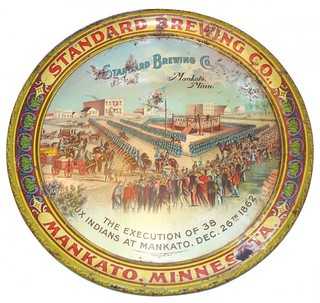
Jerry Adams of Keller, Texas writes:
I was aware of the numismatic representation of the hanging of the 38 Sioux, and have held one of those medals in my hand and examined it first-hand. They are evidently pretty rare as it is the only one I have ever seen "in hand". The one I saw and handled was at the National Token Collectors Association annual token show in Fargo, N.D. in September 2010. Since the medal was issued in 1899 and the hanging was in 1862, some 37 years later, Mankato memorialized its history, just as Gettysburg or Chickamuga. History is often written with blood.
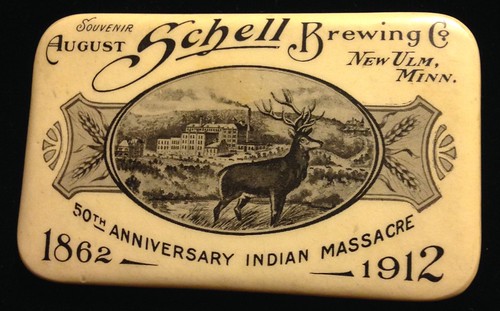
Alan V. Weinberg writes:
There are a number of rare 1862 Lakota Massacre Hanging advertising items known. One is this very rare brewery advertising mirror in my collection.
There is also a large very colorful tin serving tray depicting the mass hanging of the 38 Lakotas.
Seems the circa 1900 advertising crowd thought this Civil War era mass hanging was worth celebrating in Minnesota history.
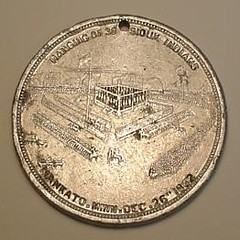
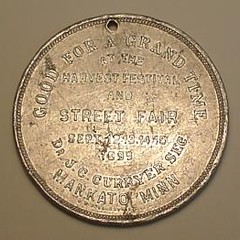
Kay Olson Freeman writes:
The token was made by Whitehead & Hoag Co., Newark, NJ. (marked “W. & H. Co. Newark, NJ” on reverse, under “Mankota, Minn”). The partnership of Benjamin Whitehead and Chester Hoag started in 1892.
The scene of the hangings was first shown contemporaneously in Frank Leslie’s Illustrated News in January 1863. W.H. Childs did the sketch for the lithograph. This is the source for all depictions of the hangings. I do not know who “W.H. Childs” was.
I first learned of the 1862 hangings through an article “A Souvenir Spoon with a Horrific Story” by Robert Wilhelm in the March/April 2006, SILVER magazine, p. 14.
Wilhelm’s article illustrated the scene (engraved finely) in the bowl of a silver souvenir spoon manufactured by Watson & Newell Co., Attleboro, MA. The handle of that spoon was in the “Poppy” pattern @ 1902-1904.
A different souvenir spoon, called the “Mankota Spoon,” with the same hanging scene engraved (rather crudely) in the bowl, was discussed in 2008 on the PBS TV show “History Detectives.”
That souvenir spoon was then thought to be dated @ 1902. No maker of the spoon was mentioned. Its handle design pattern differed from the Watson & Newell – not floral but baroque curves.
The TV show (segment can be read online) explained why souvenirs, such as Matt Hansen's token, would be made in the late 19th C. – early 20th C. about an event that occurred much earlier.
To read the earlier E-Sylum article, see:
QUERY: MANKATO DAKOTA INDIANS HANGING ITEMS SOUGHT
(www.coinbooks.org/esylum_v18n13a20.html)
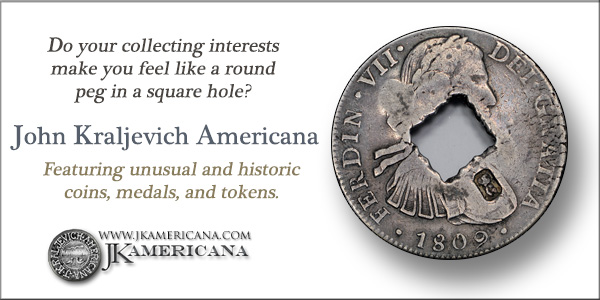
MORE ON COIN DEALER CHARLES L. STAKE
John writes:
I had Stake on my website for some time now. I am planning a full biography of him to be printed as a small book at some future date. I am glad to see there is interest in him. He had kidney and liver disorders and was a cripple. These conditions limited his capacity. He was a small time dealer, which was undoubtedly attributable to his ill health.
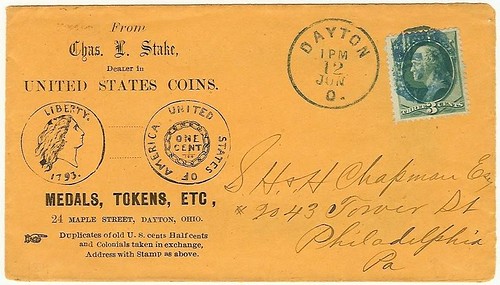
Stake, Charles Louis (1854-1886), in 1873, he was a student residing at Old (School District) No. 16, Centre Street, Dayton, Montgomery County, Ohio; from 1875 -1877: 16 Maple Street, between Perry and Wilkinson Streets, Dayton, Ohio; from 1878-1880: 24 Maple Street, Dayton, Ohio; From November 1880 : 223 South Jefferson Street, Dayton, Ohio. He was a small time coin dealer from 1875-1886, who specialized in Early American Copper.
He was born the only son of two immigrants to America, Louis Stake (c.1829/32-1920), a French émigré and his German born wife Barbara Stake (1835-1901). Charles was very frail and suffered from various medical complications and was a cripple early in life. Yet he established himself as a lesser-known and obscure coin dealer with sporadic ads in Numisma. He published a coin catalogue, monthly fixed price lists, and small mail bid auctions that averaged about 200 lots each. His largest known mail bid auction was Sale #1. August 15, 1882, 230 lots.
When he first began he had graphic illustrated letterhead and business envelopes with a hand drawing of a 1793 S.4, B.5 Chain Cent (period after date) for his numismatic advertising printed on cadmium yellow deep as well as tan colored paper stock. He was coetaneous and a true contemporary of the Chapman brothers who began dealing nearly three years before they began dealing independently from Col. John W. Haseltine. We first learn of his coin dealership in 1875 in the Dayton City Directory. However, this listing did not last but that single year and we do not see him again as a coin dealer until 1878 when he began correspondence with the Chapman Brothers.
Seven months later he published an ad in Numisma citing “a neat 16 page pamphlet” Catalogue of United States Coins, etc., for 15 cents beginning in March. (See Remy Bourne, FPL, Vol. 1). At that time he also advertised to his mailing list clients that he would bid for them at coin auction sales for a nominal fee of 10 per cent. His stock comprised of better specimens culled from change of common and scarce United States coinage as well as Colonial coins. He specialized in United States Large Cents, but also sold half cents, medals, tokens, books and electrotypes.
He was a steady customer with the Chapman Brothers from 1879-1886, and was a great haggler over prices.
Stake held at least 35 coin auction sales that were typically published monthly beginning in August 1882 until November 1885, of which, only 13 are known...
George Kolbe writes:
Since 1988, Kolbe & Fanning appear to have handled a copy or two of the 1879 Charles L. Stake list mentioned by accomplished numismatic bibliophile Dave Hirt in last week’s E-Sylum, but only two Stake auction sale catalogues have come up for sale: one his “Seventeenth Coin Sale," dated April 26, 1884; the other, his “Twenty Seventh Coin Sale,” dated February 28, 2885.
In Sales 100 and 101, however, the following quite interesting Stake publication was offered:
Stake, Charles L., Publisher. PAMPHLET. GIVING LIST OF DATES, WITH THEIR DEGREES OF RARITY, OF THE GOLD, SILVER AND COPPER COINAGE OF TH[E] [U]NITED STATES FROM 1793 TO 1858. Dayton: No. 24 Maple Street, circa late 1870s? (4) pages, last blank. Single sheet, folded in half. Once folded horizontally, a trifle dusty. Very good/near fine.
Not in Attinelli; likely issued after 1875. American Numismatic Society Dictionary Catalogue page 4568 (the sole citation located). The only example we recall ever having encountered. It is included here [as part of the John W. Adams collection of Attinelliana] because it clearly is a shameless plagiarization of the tabular portion of Mickley’s 1858 work [DATES OF UNITED STATES COINS AND THEIR DEGREES OF RARITY]. In comparison to Mickley, it is a mean production, poorly printed on cheap paper, with nary a creative flourish. The two letters of the title reproduced within brackets above are altogether missing and the spacing and typography of the remaining words in the title are askew.
Charles L. Stake was a pioneering if parsimonious Ohio coin dealer. In the 1880s, he conducted at least thirty-five coin auction sales, only a third of which are recorded in Gengerke. His various publications were apparently issued in small numbers and, at least in the case of the title at hand, were deemed unworthy of retention by his limited clientele.
- Charles L. Stake was born 1854 in Ohio. He died May 25, 1886, Dayton.
- Buried Woodland Cemetery and Arboretum, Dayton.
- In the 1880 US Census for Dayton, there is a notation that he is crippled. Charles never married. He always lived with his parents. Charles died before his parents and his only sibling, a sister, who was older and married.
- His father, Louis Stake, was born in Alsace-Lorraine. [The name may have originally been “Staeke.”]
- His mother, Barbara nee Paul, was born in Germany (Baden?) They married in Ohio in 1852. Barbara’s 1901 obituary, written in German, is online.
- Louis Stake was a “last maker” for shoes.
Charles L. Stake in Dayton, Ohio City Directories:
- 1873 – CLS, student. old no 16 Centre
- 1874 – CLS no listing. Father Louis Stake, last finisher. 16 Maple betw. Perry and Wilkinson
- 1875 and 1876 – CLS, 18 Maple betw. Perry and Wilkinson [no occupation]
- 1877 – CLS, coin dealer. 18 Maple
- 1878 – CLS. 24 Maple. [no occupation]
- 1879: CLS, old coins. 16 Maple betw. Wilkinson and Perry
- 1880 – CLS, dealer in coins, 16 Maple St, betw Perry and Wilkinson
- 1881 – CLS. 223 S. Jefferson betw. 5th and 6th [no occupation]
- 1882: CLS, numismatologist. 223 S. Jefferson, between 5 and 6th. [also listed in 1882 business directory as Numismatologist]
- 1883, 1884: CLS, dealer in old coins. 223 S. Jefferson St.
- 1885: CLS, [no occupation]. 223 S. Jefferson [final listing in directories]
Advertisement in Aug. 6, 1883, Troy (NY) Times. Charles L. Stake, 223 S. Jefferson St., Dayton, Ohio, endorses a patent medicine, Hunt’s Remedy. Stake says he was a “severe sufferer of weakness of kidneys and torpid liver.” [which was cured by Hunt’s Remedy]
To read the complete article, see:
STAKE, CHARLES LOUIS
(https://sites.google.com/site/numismaticmallcom/encyclopedic-dictionary-of-numismatic-biographies/stake-charles-l)
To read the earlier E-Sylum article, see:
QUERY: CHARLES L. STAKE
(www.coinbooks.org/esylum_v18n13a09.html)
MORE ON THE MONTROVILLE DICKESON PHOTO
Thanks for your inquiry and interest in Cowan's Auctions. Thanks as well for providing us with links to the images we previously offered at auction that include the gentleman identified as Perrin Whitman. This identification almost certainly came via an outside scholar and former archivist at the Smithsonian that helps us in identifying figures in these early American Indian photographs. This scholar has written several books on American Indian photography, so she truly knows her stuff! Thus, we would agree with you that the gentleman pictured in the images is Perrin Whitman.
I had asked the question that set Julia off on her research that calls into question whether the original labeling of the photo is correct or not.
The funny thing, it took me several times going back to the photos, and concentrating more not he eyes before I eventually sided with Julia on the debate.
Whether or not Dickeson would have been photographed with west coast tribal chief, I don’t know, but his area of work centered around the burial mounds and artifacts in the Ohio Valley.
I told Julia that this reminds me of another little test I made a couple years ago. I am 53 and showed my Kindergarten class picture to several people to guess which kid I was.
8 of the people I asked were women, and 10 men.
They all took a minute or two, and only 1 of the men got it correct. 6 of the 8 women picked correctly!
That is a tremendous difference in results!!
As I wrote to Julia, I would suggest that the male participants try a little experiment, and get their spouses involved!!
Show the photos to their wives, and let them choose.
There might be some surprises….women tend to look deeper, and the eyes play a more significant role.
Of course, this is a generalization, and there will be many exceptions, but short of hiring a facial recognition expert from the FBI, I would love to see the results of the spouse experiment!
Below is the composite image Steve put together with the known portrait of numismatic author Montroville Dickeson on the left, a photo of Indian interpreter Perrin Whitman on the right, and the photo of someone attributed as Montroville Dickeson with an Indian chief in the center. As always, you can click on the photo to see a larger version in our Flickr archive. -Editor
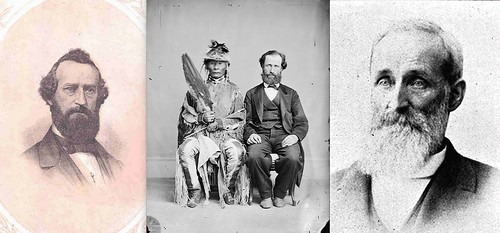
The New York Times has the best article I've seen on the dress photo topic. See:
Is That Dress White and Gold or Blue and Black?
(http://www.nytimes.com/interactive/2015/02/28/science/white-or-blue-dress.html)
To read the earlier E-Sylum article, see:
QUERY: IS IT REALLY MONTROVILLE DICKESON IN THIS PHOTO?
(www.coinbooks.org/esylum_v18n13a10.html)
SELECTIONS FROM THE POGUE COLLECTION, PART I
Lot 1002: 1794 Flowing Hair Half Dime
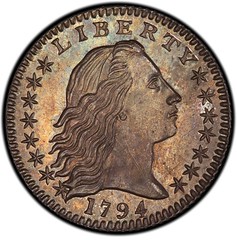
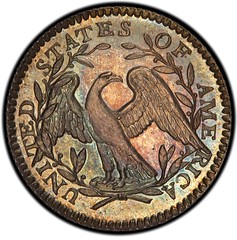
1794 Flowing Hair Half Dime. Logan McCloskey-3.
While the definition of what constitutes a Specimen has changed over time, the fact remains that a handful of special coins exists among coins struck at the Philadelphia Mint in the 18th century. They are distinctive not just for their grade, or their eye appeal, but for their method of manufacture and the care with which they were struck. Many, though not all, of these special coins happen to be from the first years of their design type. The reason they were produced was never recorded, and they rarely meet the modern definitions of what a “Proof coin” should be. However, experienced numismatists have long focused on these coins and elevated them, knowing that a scant few are just so clearly different from their ilk that particular forethought must have been involved in their creation.
This is one such coin, a first-year half dime of the Flowing Hair type that represents the birth of the denomination and the design type as coined within the Philadelphia Mint. Enough high grade 1794 half dimes have survived to identify this specimen as unlike the others. Rather than the cool, rolling, frosty luster of a typical Mint State 1794 half dime (prize coins in their own right), this example is boldly and undeniably prooflike. While many early strikes show some level of reflectivity, this coin displays purposeful polishing of the planchet that reflects both planning and a high level of interest of this particular specimen’s aesthetics from before the die faces met its surfaces. Further, the strike is far in excess of what even a boldly struck Mint State coin exhibits, with full details in all feathers, every star center, every denticle, and every strand of hair. A lint mark is noted over the left wreath end, near U of UNITED. The die state is exceptionally early, as evidenced by the lack of the thin die crack that runs between stars 5 and 6 to the back of Liberty’s head on a diagonal through E of LIBERTY on the vast majority of coins.
To read the complete lot description, see:
1794 Flowing Hair Half Dime. Logan McCloskey-3. Rarity-8 as a Specimen. Specimen-67 (PCGS).
(www.stacksbowers.com/BrowseAuctions/LotDetail/tabid/
227/AuctionID/6071/Lot/1002/Default.aspx)
Lot 1034: 1796 Draped Bust Dime

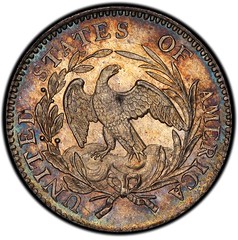
1796 Draped Bust Dime. John Reich-4. Rarity-4. Mint State-66+ (PCGS).
The finest example of a coin may not always be the prettiest, but this Superb Gem JR-4 1796 dime is almost certainly both...
Pedigree: Provenance: The Malcolm N. Jackson Collection; United States Coin Company’s sale of the Malcolm N. Jackson Collection, May 1913, lot 1000; Hank Rogers Collection, likely acquired in the 1940s; Hank Rogers to Jimmy Hayes at the American Numismatic Association Convention in New Orleans, by sale, August 1972; Jimmy Hayes Collection; Stack’s sale of April 1983, lot 1139; Paramount’s session of Auction ’84, July 1984, lot 612; Foxfire Collection (Claude E. Davis, MD); acquired with the Foxfire Collection, en bloc, by sale, October 5, 2004.
To read the complete lot description, see:
1796 Draped Bust Dime. John Reich-4. Rarity-4. Mint State-66+ (PCGS).
(www.stacksbowers.com/BrowseAuctions/LotDetail/tabid/
227/AuctionID/6071/Lot/1034/Default.aspx)
Lot 1128: 1808 Capped Bust Left Quarter Eagle
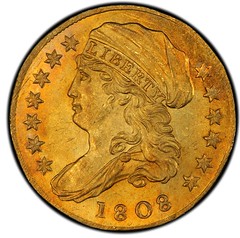

1808 Capped Bust Left Quarter Eagle. Bass Dannreuther-1.
Celebrated by numismatists for over a century, this coin has been lavished with an embarrassing array of superlatives. Abe Kosoff called it “a dream coin, out of the famous Col. Green Collection,” further saying “to own this gem is to own a prize, indeed.” Its virtues have been sung by David Akers, Jimmy Hayes, and John Dannreuther (who broke his arm while accompanying Jimmy Hayes to buy this coin in 1983; luckily, the seller, Dr. Herbert Ketterman, was capable of setting the fracture). David Akers kept a framed photograph of this coin on his office wall.
Provenance: Lorin G. Parmelee Collection, before 1890; New York Coin and Stamp Company’s sale of the Lorin G. Parmelee Collection, June 1890, lot 856; John Story Jenks Collection; Henry Chapman’s sale of the John Story Jenks Collection; December 1921, lot 5792 (plated); Col. E.H.R. Green Collection; Col. E.H.R. Green estate to Burdette G. Johnson, via Eric P. Newman; B. Max Mehl’s Golden Jubilee sale (Jerome Kern), May 1950, lot 11; Dr. J. Hewitt Judd to Dr. Herbert Ketterman; Dr. Ketterman to Jimmy Hayes in Kansas City, Missouri, via sale, 1982; Stack’s session of Auction ’84, July 1984, lot 1372; David W. Akers Inc.’s session of Auction ’89, July 1989, lot 1361.
To read the complete lot description, see:
1808 Capped Bust Left Quarter Eagle. Bass Dannreuther-1. Rarity-4. Mint State-65 (PCGS).
(www.stacksbowers.com/BrowseAuctions/LotDetail/tabid/
227/AuctionID/6071/Lot/1128/Default.aspx)
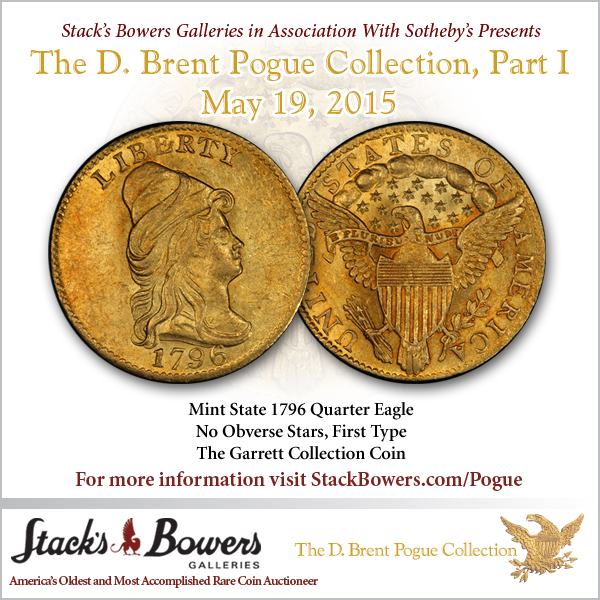
COMPARISON BETWEEN COIN AND BOOK COLLECTING
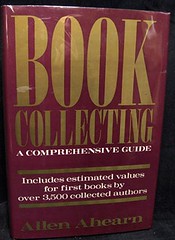 I was reading Allen Ahearn's "Book Collecting: A Comprehensive Guide" (G.P. Putnam's Sons, New York, 1989) tonight. He makes a comparison between coin collecting and book collecting, and the market forces and factors in each discipline.
I was reading Allen Ahearn's "Book Collecting: A Comprehensive Guide" (G.P. Putnam's Sons, New York, 1989) tonight. He makes a comparison between coin collecting and book collecting, and the market forces and factors in each discipline.
"The prices in this book are intended only as guides. Most dealers in collectible books do not handle rare books per se; they handle scarce books. However, very fine copies of scarce books are rare. These fine copies command high prices from knowledgeable collectors and libraries because these buyers realize the true relative scarcity of such material. I am certainly not particularly knowledgeable about other collecting fields such as coins or stamps, but my impression is that if an individual wanted five very fine examples of a certain 'rare' coin or stamp and was willing to pay the going (not an inflated) price, they could be found within a few weeks. On the other hand, if an individual wanted to buy five very fine copies of a certain edition of a particular title, it might take a few years. And this is not just for books costing thousands of dollars; it's true of books that sell for only a few hundred dollars (or less)."
Ahearn's analysis of the rare-coin market, and also of the rare-book market, was modified a bit when the 1995 edition of his book was published. "Very fine copies of scarce books are rare" was softened to "very fine copies of scarce books border on being rare," and all discussion of particular "very fine" rare coins being hunted down five at a time over a matter of weeks, as if they were Thomas Kinkade prints or limited-edition Beanie Babies, was completely gone.
RAY WILLIAMS FEATURED IN APRIL 2015 NUMISMATIST ARTICLE
Dave Ginsburg writes:
 The New Jersey Numismatic Society is pleased and proud to note that the April 2015 issue of The Numismatist includes an article by Ray Williams, our Vice President!
The New Jersey Numismatic Society is pleased and proud to note that the April 2015 issue of The Numismatist includes an article by Ray Williams, our Vice President!
The article “An Evening with my Collection” features Ray’s reflections on nine types of coins and medals in his collection, which focuses on coins, tokens and medals that were used in, or pertain to, the lands that became the United States of America before the construction of the United States Mint in 1792.
Congratulations, Ray!
Ray adds:
For more information about The Numismatist, see:
www.money.org/the-numismatist

HAND-ENGRAVED 1849 PATTERN GOLD DOLLAR
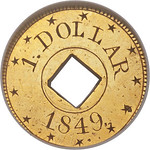

Our April 22 - 26 CSNS US Coins Signature Auction features one of the most interesting patterns in the entire series, the possibly unique Judd-115 1849 gold dollar . This is the only U.S. pattern that was hand-engraved, and as such it is distinctive and highly collectible. These patterns were emergency issues that were hand-engraved to simulate what a struck coin would look like with a square hole in it. They were needed in a hurry because a lame-duck Congressman from North Carolina, James Iver McKay, was pressing hard for the issuance of the pieces (mostly as an outlet for the gold mines from his native state). By January 26, 1849 Congressman McKay was in possession of one of these pieces (presumably this one). On January 30, six additional specimens were produced and sent by Mint Director Robert Maskell Patterson to other Congressmen.
All of the seven known pieces of the Judd-115s and 116s have been weighed and three have been metallurgically tested. This particular piece is by far the heaviest of the seven possible pieces at 22.76 grains and it has a specific gravity of 18 - pure gold has a specific gravity of 19.3. The gold dollar adopted later in 1849 weighed 25.79 grains. The closest weight of the other six pieces is 19.02 grains. The lightest of the six others is the Chase Manhattan piece that weighed only 15.28 grains. Metallurgical testing of two of the other pieces showed a gold content of only 52.7% and 51% gold. Close examination of the seven known Judd-115/116 patterns strongly suggests the present piece may be the only actual Judd-115 in existence, as it is the only piece struck in coin gold (90% gold). The other six specimens should more properly be designated as Judd-116s. The tests conducted on those other six pieces also recommend reexamining the assertion that the Judd-116 pieces are gold-plated silver. Instead it suggests they are gold-silver-copper alloy pieces, but not gold-plated.
This coin is simply laid-out with a square central perforation. On the obverse, around the perforation, is the legend 1.DOLLAR. 1849. The reverse has a laurel wreath around the perforated center and outside that U. STATES OF AMERICA. Struck in gold with a plain edge. Composition - 90% gold, 2.5% silver, 6.5% copper, weight = 22.8 grains.
This piece is an attractive example with lustrous, lightly marked antique-gold surfaces. A small mark near the reverse rim at 2 o'clock serves as a useful pedigree marker. The eye appeal is outstanding.
To read the complete lot description, see:
1849 PG$1 Gold Dollar, Judd-115, Pollock-130, Possibly Unique
(http://coins.ha.com/itm/patterns/1849-pg-1-gold-dollar-judd-115-pollock-130-possibly-unique-ms61-ngc/a/1219-5529.s)
FREEDOM’S FIRST CON
As detailed in the landmark exhibition at the New-York Historical Society a few years back, New York City has a long, and generally overlooked, history as a capital of slavery. In 1790, one in five white households in the city owned a slave, and although there was a growing free black community, it was not until over a half-century after the American Revolution that the state of New York formally abolished slavery on July 4, 1827.

The city was home to the American Anti-Slavery Society, which distributed the copper token above, and abolitionist sentiment was certainly on the rise in the 1830s and 1840s. And yet racism was hardly in abeyance, and the asymmetrical power relationship between white and black was something that African-Americans had to confront and deal with on a daily basis.
Shane White focuses on how this power dynamic played out in the course everyday monetary transactions, making use of a wealth of material drawn from legal records in the Municipal Archives. One commonality that emerges is of the problems that black businesses had dealing with white customers, who variously ran up and out on charges, tried to pay with counterfeit money, or otherwise abused black owners.
White also shows how some African-American turned the complicated monetary system to their advantage. The titular “first con” refers to the the practice of “burning,” a scam wherein black men took money off white “marks” by offering to change their bank notes for silver and gold coins at friendly rates. Gangs of black “burners” often employed white confederates, and lurked around the city’s docks and exchange offices, looking for new arrivals with fat pocketbooks. A variety of tricks were used to induce the mark to take out their money, but once they did the burners simply grabbed the cash and ran. This rather crude con first emerged in the 1830s, but the article traces how the scam was refined over the years.
To read the complete article, see:
FREEDOM’S FIRST CON
(www.anspocketchange.org/freedoms-first-con/)
THE BOOK BAZARRE
DIX NOONAN WEBB OFFERS AUSTRALIAN CONVICT TOKENS
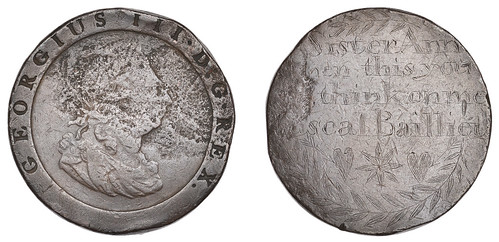
Pascal Baillieu’s plea to his sister Ann engraved on a George III penny
Britain’s harsh early 19th century penal system sentenced many people to be transported to Australia for offences that would not now be regarded as major crimes. Some were sent to the other side of the world for life, others received fixed sentences, but for all there was the heartbreaking prospect that they might never see their families again. To give their loved ones a memento to remember them by, some convicts engraved their names and messages on coins and some of these ‘transportation tokens’ are to be auctioned by Dix Noonan Webb at its sale of Coins, Tokens and Historical Medals in London on 13 May 2015.
The most moving of these messages was stipple-engraved on a 1797 George III penny by Pascal Baillieu, who, ironically, had been convicted of forging counterfeit coins and being in possession of impressions and moulds for coining. He was sentenced to seven years transportation at Bristol Quarter Sessions on 9 October 1837. Pascal had been born in Bristol in 1804 and was evidently very fond of his sister Ann, who was two and a half years younger. Before he sailed for New South Wales on the Lord Lyndoch in April 1838 he engraved: ‘Sister Ann when this you see think on me. Pascal Baillieu.’ Unlike many convicts who were transported for life or who chose to stay in Australia when their sentences ended, Pascal returned to England after receiving his Certificate of Freedom in December 1844. So perhaps and he and Ann were reunited. His transportation token, which is in fair to fine condition, is expected to fetch £150 to £200 at the Dix Noonan Webb auction.

Charles Chapman's engraved 1797 George III penny
The fate of Charles Chapman, who was sentenced to transportation for life at Worcester Assizes in March 1829 for an unspecified offence, is less clear. As he awaited sentence, probably aware of his impending fate, he stipple-engraved ‘Charles Chapman, Aged 19 yrs, Febury (sic) 11 1829’ on another 1797 George III penny. Presumably the engraved coin was handed to a relative before he embarked on the Katherine Stewart Forbes in October 1829, arriving in New South Wales the following February. Charles probably never saw his family again. His transportation token, which has deliberate pitting on the obverse while the reverse is about very fine, is estimated at £200 to £300.
Both these pieces are from the collection of engraved coins formed by the late Richard Law, who was born in Huddersfield, West Yorkshire in 1943. On leaving school Law took a job in the textile business. He became a wool buyer and, after the industry’s decline, worked in the office of a local iron foundry. It is thought that the gift of an 1838 Victorian threehalfpence from his father in 1960 triggered his lifelong interest in collecting coins, historical medals and postcards. He became President of the Huddersfield Numismatic Society and Treasurer of the Huddersfield Postcard Society. Law died in 2014.
To find out more about the sale visit www.dnw.co.uk or telephone 020 7016 1700
To read the earlier E-Sylum articles, see:
CONVICT LOVE TOKENS?
(www.coinbooks.org/esylum_v06n33a10.html)
CONVICT LOVE TOKEN BOOK AVAILABLE
(www.coinbooks.org/esylum_v06n37a04.html)
ROWLAND CONVICT LOVE TOKEN SOLD
(www.coinbooks.org/esylum_v17n37a37.html)
STANLEY GIBBONS FAILS TO COLLECT FOR £1M COIN SALE
A £1m coin was at the centre of a “perfect storm” of failed deals that forced Stanley Gibbons, the UK stamps, rare coins and collectibles trader, to issue a profit warning on Thursday, sending shares down more than 10 per cent. The group, which has its roots as a specialist stamp dealer but has ambitions to be the “Amazon of collectibles”, said it failed to complete the sale of stamps and coins worth more than £1m before the year-end. The company expected that results in the year to March 31 “will be materially below current market expectations”.
About 40 per cent of Stanley Gibbons’s business is in the volatile dealing of high-value collectibles, but the company is planning to reduce that to just 10 per cent by 2017.
One sale fell through after an unnamed American coin collector failed to pay for a £1m coin, forcing the company to pull the deal, said Michael Hall, chief executive.
“It was like a perfect storm scenario; what can go wrong next? That is how it felt,” he said. Shares had fallen 10.48 per cent to 238.14p by lunchtime trading in London.
The profit warning illustrated the need for the group “to move from our traditional dealing business and towards being an online marketplace and an auctioneer,” Mr Hall said.
To read the complete article, see:
Stanley Gibbons warns on profits as £1m coin sale collapses
(www.ft.com/cms/s/0/2de1a8cc-d925-11e4-a8f1-00144feab7de.html#axzz3WOTB1B3F)
QUEEN HOSTS 2015 MAUNDY SERVICE
 The Queen has handed out Maundy money to 178 pensioners at a service in Sheffield Cathedral.
The Queen has handed out Maundy money to 178 pensioners at a service in Sheffield Cathedral.
It is the first time South Yorkshire has played host to the service, which recognises the work of elderly people to their community and church.
This year, 89 women and 89 men - one for each of the Queen's 89 years - received the Maundy money.
The Dean of Sheffield, the Very Reverend Peter Bradley, said it was a historic moment for South Yorkshire.
"We are deeply honoured to be chosen to host the Royal Maundy Service on behalf of our nation," he said.
"This service is a special opportunity to recognise individuals who have worked to make a positive contribution to the community."
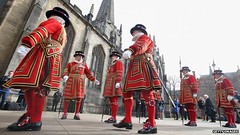
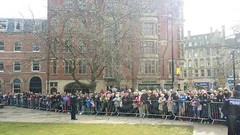
The monarch's Maundy Thursday service has been held in England since the 12th Century, to mark Jesus washing his disciples' feet. During the service the Queen distributed specially-minted money to the men and women, all from the Sheffield area. The recipients were given two leather pouches, one of which contained Maundy coins equating in pence to the Queen's age.
To read the complete article, see:
Queen hosts Maundy service at Sheffield Cathedral
(www.bbc.com/news/uk-england-south-yorkshire-32152147)
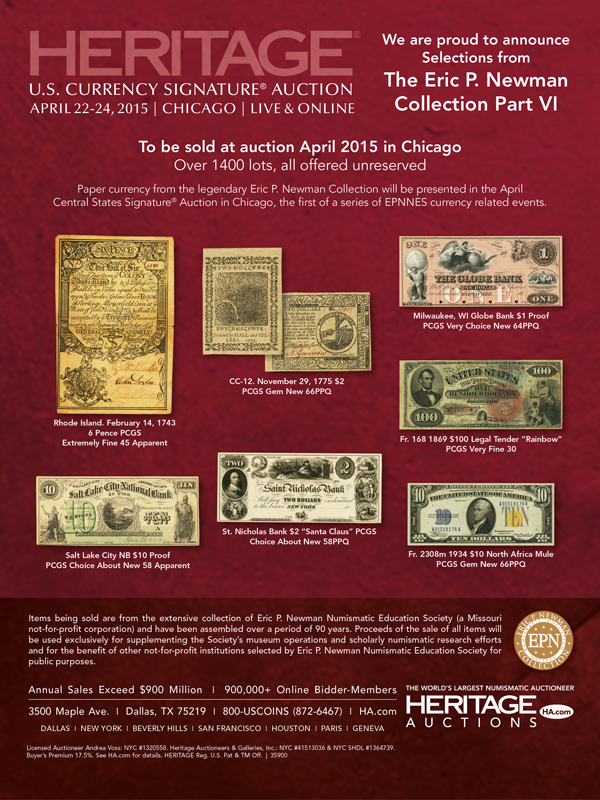
PERSHING AND MARSHALL CONGRESSIONAL GOLD MEDALS
Scott Miller writes:
A few weeks ago there was some discussion about designs of 20th century Congressional gold medals. Some designs by Anthony de Francisci can be seen on the Smithsonian’s art database on SIRIS. I am attaching links to medals for Pershing and George C. Marshall.


General John J. Pershing Medal
Artist: de Francisci, Anthony, 1887-1964, sculptor.
Title: General John J. Pershing Medal
Dates: 1947.

George C. Marshall Medal
Artist: de Francisci, Anthony, 1887-1964, sculptor.
Title: George C. Marshall Medal (obverse)
Dates: 1946.
To read the complete entries, see:
General John J. Pershing Medal (obverse), (sculpture).
General John J. Pershing Medal (reverse), (sculpture).
George C. Marshall Medal (obverse), (sculpture).
To read the earlier E-Sylum article, see:
THE TRUMAN CONGRESSIONAL GOLD MEDAL
(www.coinbooks.org/esylum_v18n03a13.html)
CHARLES RILEY NUMISMATIST MEDAL 2015

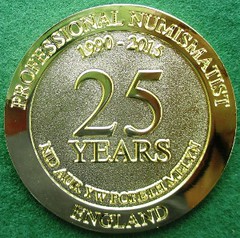
 To commemorate 25 Years in the numismatic business, and 10 Years working for myself I have issued the medal pictured above. The harpist was designed by renowned English medallist Joseph Moore, originally appearing on Welsh eisteddfod medals of the 1860s; I’ve adopted it as my logo. This and the Welsh language legend are a nod to my personal interest in Welsh medals as well as being a jocular reference to the medal’s metal content (it is a
gilded zinc-based alloy).
The diameter is 50mm.
To commemorate 25 Years in the numismatic business, and 10 Years working for myself I have issued the medal pictured above. The harpist was designed by renowned English medallist Joseph Moore, originally appearing on Welsh eisteddfod medals of the 1860s; I’ve adopted it as my logo. This and the Welsh language legend are a nod to my personal interest in Welsh medals as well as being a jocular reference to the medal’s metal content (it is a
gilded zinc-based alloy).
The diameter is 50mm.
To order: The medal will be given free to those who order another stock medal from this website (one Riley medal per customer), or you can buy the Riley medal on its own –
In the UK: £12 per medal, including recorded delivery postage. Payment can be made by Paypal using my email address (charles.riley@virgin.net) or by cheque made payable to Charles Riley
In the USA/Canada: £19 (US$30) per medal including registered postage. Payment can be made by Paypal using my email address (charles.riley@virgin.net)
Other countries: please email me. The basic price is £10 per medal plus relevant registered postage cost to your country.
Please note: I found it very difficult to photograph this medal. In my opinion it appears much better in the flesh!
To read the complete article, see:
www.charlesriley.co.uk/RileyMedal2015.htm
MEDALLIST JOSEPH MOORE
MOORE, JOSEPH (Brit.). Medallist of the second half of the nineteenth century, born at Birmingham, 17 February 18 17, died there in 1892.
His father had served in the Peninsular War and met with a serious accident when the future Engraver was yet a child. At ten years of age he persuaded his parents to allow him to try to earn his own living; he entered the office of a then well-known silver- smith, and while there he learned drawing under Henry Follet Osier.
His next step in life was when he was apprenticed tor eight-and- a-half years to Thomas Halliday, a die-sinker, of Newhall Street, nearly opposite to Little Charles Street. His training with Halliday was most valuable to him. In starting business for himself he began with dies for button making, which at that time was one of the chief, if not the greatest, industry of the town.
Joseph Moore, at the Exhibition of 1851, was awarded the prize for excellent workmanship in the manufacture of buttons.
 Before the term of his apprenticeship drew to a close he had a
strong desire to become a medallist. He obtained the requisite
tools, fitted up a bench in the attic of the house in which he then
lived, and, rising every morning at four o'clock he would copy some of the designs he had brought from his shop on the previous
night.
Before the term of his apprenticeship drew to a close he had a
strong desire to become a medallist. He obtained the requisite
tools, fitted up a bench in the attic of the house in which he then
lived, and, rising every morning at four o'clock he would copy some of the designs he had brought from his shop on the previous
night.
When eighteen years of age he for a short time was under the tuition of Samuel Lines, in whose school have been taught so many talented engravers and die-sinkers.
In 1844, it was suggested to Moore that he might make a coin which would be an improvement on the heavy and cumbersome penny-piece which was then in currency. He designed a model penny — absolutely his own idea — of about the size of a farthing, inside the raised rim of which was a small piece of silver which brought its value up to the proper standard. The rim was ingeniously devised with the object of making the penny distinguish- able from other coins of a similar size in the pocket merely by feeling it. There was an enormous demand for these tokens; so great, indeed, that Wyon, the coin die-sinker to the Mint, when he came to consult Moore about his system of making dies so that they would not break, good-humouredly explained that they had met with such favour with the public that he had been compelled to advertise the fact that they were the result of private enterprise and not a Government issue.
For more information, or to order, see:
CHARLES RILEY NUMISMATIST MEDAL 2015
(www.charlesriley.co.uk/RileyMedal2015.htm)
THE BOOK BAZARRE
MALAYSIA BANK AUCTIONS SPECIAL SERIAL NUMBERS
 A Malaysian collector paid RM76,000 for a RM100 bank note bearing the serial number AA8888888 at an auction by Bank Negara Malaysia.
A Malaysian collector paid RM76,000 for a RM100 bank note bearing the serial number AA8888888 at an auction by Bank Negara Malaysia.
This was revealed by MNP Auctioneers (Central) Sdn Bhd managing director Stephen Soon, who was in charge of the auction conducted at Bank Negara’s head office here yesterday.
The number eight is a homophone for the word “prosperity” in Chinese, hence its popularity.
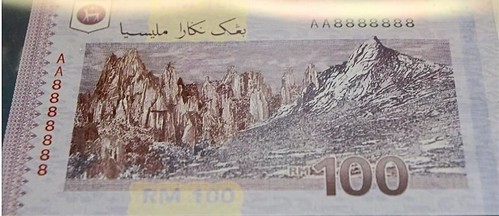
“In Malaysia, twin prefixes and solid numbers are the most popular among collectors,” said Soon.
He added that the value of the bank notes was determined by the serial numbers, and not by the actual value of the notes.
“People often think that bank notes with these types of unique numbers can only be obtained under the table, but through this auction anyone can bid for them,” he said.
Soon said that one of the reasons Bank Negara had hired his company was to change such perceptions.
“Anyone can register and bid for the notes. All they have to do is pay RM300 for registration and bid for the notes they are interested in,” he said.
He added that the registration fee was refundable, and was imposed to ensure the “quality” of attendees.
A total of 17 bank notes were auctioned off yesterday. It was the second year that MNP had conducted the auction for the central bank.
“What is special this year is that we framed the bank notes and the successful bidders were also be given a certificate of authenticity,” he said.
To read the complete article, see:
Malaysian collector pays RM76,000 for RM100 bank note
(www.thestar.com.my/News/Nation/2015/03/30/Malaysian-collector-pays-RM76000-for-RM100-bank-note/)
DEFIANCE BANK BUILDING HOUSES TUTTLE MUSEUM
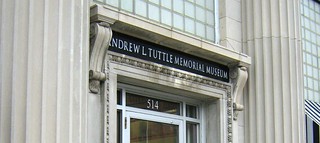 If you were to stop Defiance residents and ask where the Andrew L. Tuttle Museum is, they probably could tell you, “On Third Street. It used to be some bank building.”
If you were to stop Defiance residents and ask where the Andrew L. Tuttle Museum is, they probably could tell you, “On Third Street. It used to be some bank building.”
But if you were to ask them who Tuttle was, you would likely get a blank look. Although Mr. Tuttle was born in Defiance in 1918 and graduated from Defiance High School, there are still few details known about his life. The museum is rare because most museums are named for famous people, and no one really knows much about Andrew L. Tuttle. A portrait shows a handsome young man with a serious look.
“I first heard about him in 2003,” says Defiance historian Randy Buchman. “He was a real estate evaluator on the international level. He was coming back from Florida when he was killed in an automobile accident. Among his things was a hand-written will saying that if the City of Defiance would fund a museum in his honor, they could have all his coin and early American Indian artifacts as well as other memorabilia he had collected on his overseas trips.”
Both the two main collections are large. His international travels gave Tuttle great opportunities to add to the coin collection, and Indian artifacts had been found and saved by both his father and grandfather, as well as by Andrew himself.
The coin collection is so vast that only portions are shown at one time, with displays changed periodically. Coins are shown according to the current theme of the museum — foreign coins (and paper money) may be displayed according to country, while others are from historical eras. (When I visited, the focus was on colonial America up through the War of 1812.)
The coins currently on display are housed in the vault of the former bank building.
To read the complete article, see:
One man’s legacy
(www.countryliving.coop/departments/mans-legacy/)
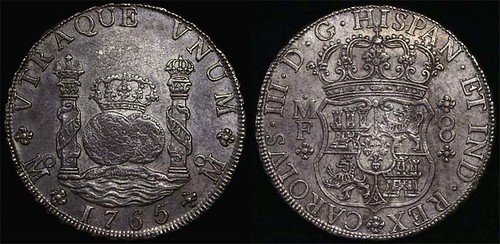
Mexico Pillar Dollar 1765
The Andrew Tuttle collection of coins and currency is extensive, including traditional and nontraditional coinage and currency from many countries and time periods. Presently coins from the United States Colonial Era are displayed in the massive vault that was part of the former Home Saving and Loan, and which now is an attraction of the Andrew L. Tuttle Memorial Museum.
To read the complete article, see:
Tuttle Coins from the American Colonies
(www.cityofdefiance.com/main/index.php/tuttle-coins-from-the-american-colonies)
To read the earlier E-Sylum article, see:
WOMAN TURNS BANK BUILDING INTO HER HOME
(www.coinbooks.org/esylum_v18n13a31.html)

HARLAN J. BERK 193RD BUY OR BID SALE
 We are pleased to announce the launch of our 193rd Buy or Bid sale. This sale has a 542 ancient Greek, Roman and Byzantine coins as well as 21 world coins and 46 antiquities & antique maps. Our Buy or Bid sales just following the New York International Coin Fair are some of our most exciting of the year. At the Fair we have the opportunity to meet with all our colleagues from around the globe, as well as buy exciting inventory for our stock. In addition to the obvious commercial advantages of attending the sale, we have the luxury of meeting many of our customers face-to-face. In our current technology-driven world, meeting customers is a small luxury that we enjoy. Now to the sale….we hope that you will find this sale as exciting as we do.
We are pleased to announce the launch of our 193rd Buy or Bid sale. This sale has a 542 ancient Greek, Roman and Byzantine coins as well as 21 world coins and 46 antiquities & antique maps. Our Buy or Bid sales just following the New York International Coin Fair are some of our most exciting of the year. At the Fair we have the opportunity to meet with all our colleagues from around the globe, as well as buy exciting inventory for our stock. In addition to the obvious commercial advantages of attending the sale, we have the luxury of meeting many of our customers face-to-face. In our current technology-driven world, meeting customers is a small luxury that we enjoy. Now to the sale….we hope that you will find this sale as exciting as we do.
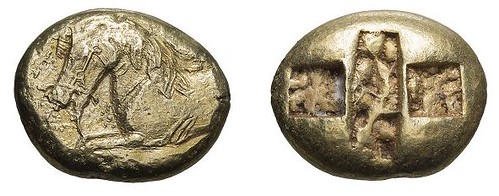
Lot 6: Uncertain Ionia Electrum Horse stater. This coin symbolizes a few important milestones in the history of coinage. It is among the first types ever minted following the blank and striated coinage from the same area. It also is among the earliest to show imagery on the obverse. Like the coinage of Phanes which reflects a stag, this early coin shows a forepart of a horse and also like the Phanes, a beautifully detailed three-part incuse punch.
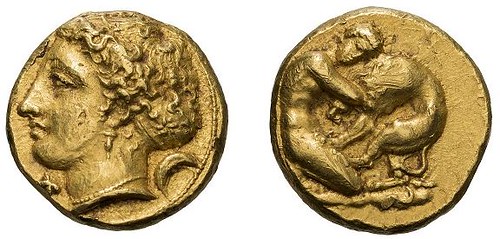
Lot 12: Sicily, Syracuse 100 litrae. We have a few coins in our sale that have been part of collections for over 100 years. This coin is one of them. Buying pedigreed coins is more and more sought after not only for tracking one’s collection, but just for the sheer pleasure of knowing that someone a lifetime ago once owned this coin. This lovely Syracuse piece was part of many illustrious collections and auctions. Most notably the Jameson collection, Hess-Leu 1956 and the O’Hagan collection from 1908.
Lot 14: Alexander III, the Great distater. Staters of Alexander and his father Philip II are quite ubiquitous in today’s coin market. Distaters are more elusive. This is a reasonably priced example of a type not found so easily.
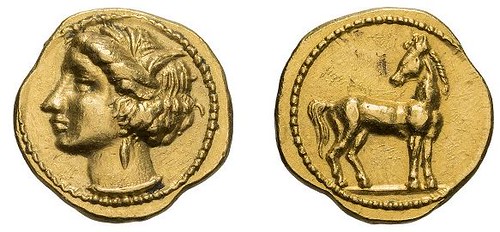
Lot 20: Zeugitania, Carthage EL ⅕ stater. This small coin (9mm) is an absolutely pristine example mirroring the imagery found on the staters.
Lot 52: Neapolis nomos. An exceptionally beautiful coin with sharply struck features.
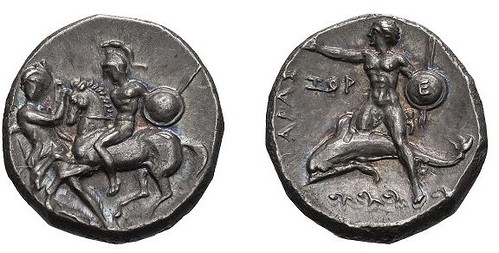
Lot 56: Calabria, Tarentum nomos. Quite frankly we have very rarely come across a coin that embodies such beauty. Iridescent toning and a reverse of the warrior that shows the musculature in sharp detail.
Lot 59: Lucania, Velia didrachm. A beautifully struck example where the details of the crest are sharp. Difficult to find in this state of preservation.
Lot(s)66-68: Three coins from Siculo-Punic. Lot 66 is a wonderfully struck piece with an amazing pedigree to match. From the Niggler collection which was auctioned off by Leu/M&M in 1965.
Lot 70: An archaic stater from Lete or Siris. Among the earliest of staters from Lete or Siris. This coin shows the satyr/nymph duo as standing figures rather than the more common types from Thasos where the satyr is carrying the nymph away.
Lot 109 and 110: Two extremely lovely specimens from Larissa. One is a drachm and the other a stater but both have in common a beautifully sculpted portrait of Larissa.
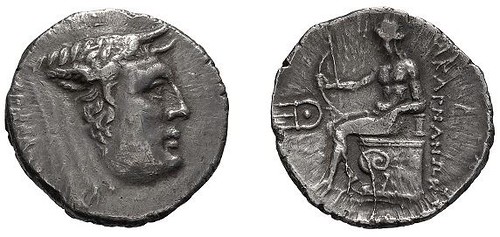
Lot 112: Akarnarian League stater. This coin is not only a rarity with a more “humanized” head of the man headed bull than say of another counterpart Gela, but also a pedigree going back to a 1905 Hirsch auction.
Lot 113: Aetolia stater. This coin, purchased by our firm in Gemini XII is a stunning example with a blockbuster pedigree to match. Dating back to the 1910 Hirsch auction and part of the Bement and Spencer-Churchill collections.
Lot 117: Athens tetradrachm Starr-Group IIA. This early coin from Athens is wonderfully struck with full crest, unadulterated silver and archaic owl. A beautiful early example of Athenian coinage
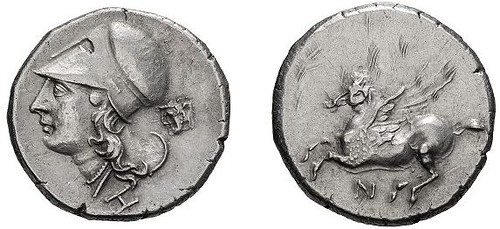
Lot 136: An unusually rare stater from the Corinthian colony of Stratus on Acarnania. This piece displays a masculinized image of Athena with a wonderfully struck symbol of a man-headed bull. A beautiful and fascinating type.
Lot(s) 141-148: A wonderful, new to market collection of Cretan coinage. This collection, assembled in the UK over several years, is a group of coins that are very rarely encountered on the market. Coins from Crete are fascinating; many are filled with imagery of famous myths and exotic animals. Lot 107 at first glimpse seems to be a slightly abstract coin from Aegina. This coin was in fact copied by the Cydonians from their Aeginian neighbors. Lot 142 is a seldom seen coin from the city state of Eleutherna. This abstract version of the naked Apollo on the obverse varies greatly from the more common type. Lot 144 is a die engraver error with the crest of Athena missing; a fascinating anomaly. Lot 146 and 147 are two examples from Lyttus with an eagle and a boar. Both archaic and abstract in nature, one is sharply struck and the other shows the eagle in a state of flight, mirroring the lovely coinage of Elis. Finally lot 148 is a coin from Rhaucus which is seldom seen on the market.
Lot(s) 183-193: A pleasant run of Bactrian drachms.
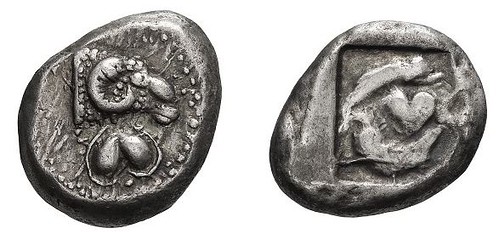
Lot 195: Our cover coin, Cyrenaica, Barca didrachm. An unpublished and quite lovely didrachm from Barca which shows the now extinct silphium plant along with a well-struck ram. This coin is both fascinating and historic.
To read the complete article, see:
193rd Buy or Bid Sale Catalog
(http://hjbltd.com/ancientcoins/cncc.asp?inventorygroup=cc)
THE BOOK BAZARRE
BANKNOTE ORIGAMI ANIMALS DISPLAYED IN RUSSIA
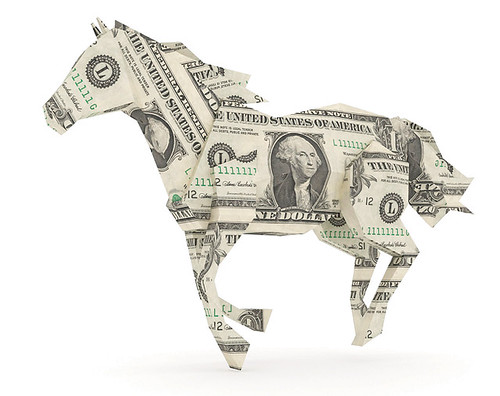
Origami articles made of $100-dollar banknotes were put on display at an interactive exhibition, titled 100 Dollar Origami, which opened in Russia’s second largest city of St Petersburg on Saturday.
The exhibition is timed to mark the birthday of the dollar sign that is believed to have been invented by American businessman Oliver Pollock in April 1778. “The exhibits are animals, fishes, dinosaurs and various other objects, like apparel, folded out of $100 banknotes,” the press service of the State Museum of Urban Sculpture, the venue of the exhibition, said.
 Visitors will be treated to “dollar tea”, a drink brewed from the dollar banknotes.
Visitors will be treated to “dollar tea”, a drink brewed from the dollar banknotes.
Apart from that, they will be able to play chess with Russian roubles and US dollars, instead of black and white chess pieces. After the exhibition, the banknotes will be carefully unfolded and deposited into Sberbank.
The organisers, however, are not certain that a banknote would still be valid after being bathed in boiling water.
There is a notation "Pics for representation only". So maybe these aren't even images of art from the exhibit. I guess everything about this article is fake. But it's dated April 5th, not April 1st. Bizarre. -Editor
To read the complete article, see:
Animals made of folded 100 dollar banknotes displayed in Russia!
(www.mid-day.com/articles/animals-made-of-folded-100-dollar-banknotes-displayed-in-russia/16116169)
THE BOOK BAZARRE
FEATURED WEB PAGE: EXONUMIST.COM
This week's Featured Web Page is exonumist.com.Welcome to exonumist.com, Keith's online token collection.
I am a collector of all kinds of tokens. I currently have thousands of transportation, parking, game, car wash, and hard time tokens, although I am particularly interested in tokens from New York City. This website currently shows only my transportation tokens, but will eventually showcase every token that I own. Hopefully, in time, this site will become a meeting place where exonumists can buy, sell, and trade tokens with fellow exonumists around the world.
If you are a collector of transportation, parking, car wash, or pretty much any other type of token, consider joining the American Vecturist Association. The AVA is a group of token collectors across the US and abroad, and is a great way to obtain tokens for your collection.

www.exonumist.com
